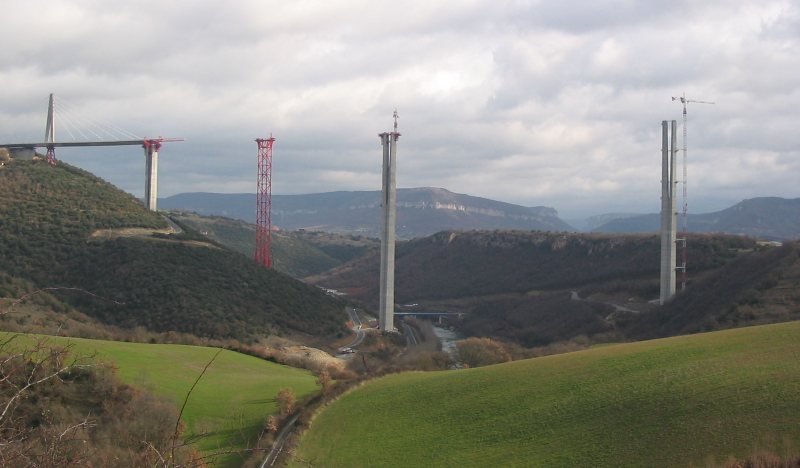Any bridge with more than one span has a pier [Note: laymen will use the term 'span' to refer to an entire bridge. Presumably because the term "Spans the entire width of the river" just means crosses the river. But technically it means the place between supports. So if there's a big pier in the middle of the river then there's actually two spans to get over the river]. Essentially just whatever is holding up the bridge between either end. Some bridges have lots of piers, some have none, Greenfield has exactly one. A pier can be many different things and built many different ways. Unless it's an entirely timber structure, it's almost always made out of concrete (steel is inefficient for this application) but it can be shaped and formed and designed in all sorts of different ways.
 |
| The Lake Pontchartrain Causeways have a lot of spans and piers. |
Typically the easiest and the cheapest pier for standard bridge uses a series of columns. Taller bridges, ones crossing over multi-layered roadways or deep rivers and trenches, may use a single, very large column per pier. Because Greenfield is wide and just crosses the one road: the multi-column approach was used (there are more approaches you can use, and a lot more subcategories, but this is good enough for a start).
Designing these piers requires looking at a large number of different loading patterns. What if there's one truck pushed all the way over to the side of the road here, and no others? What if there's one at the edge, but then one spaced 15' closer to center? What about the wind loading? What direction? For Greenfield, I calculated (using some programming code I wrote, not by hand) around 50,000 different loading cases. It doesn't scratch the surface of the number of possible combinations you could check under the code. In fact, I calculated that if I checked every load placed to the nearest foot only, that it would be approximately 10^21 different combinations.
 |
| You can see the columns in various stages of completion. The ones on the far end are poured and the forms stripped. In the middle the rebar has been placed and forms placed around it that will give the column its shape. On the close end only the rebar cage has been placed. |
I'm actually responsible to make sure the bridge won't fail under any of those combinations, and there's nothing that says I only have to check to the nearest foot, if something spaced at 3 inches is more critical then that's my responsibility too! This is where being an engineer actually means doing engineering rather than just calculating. A sense of what controls, where, and what level of precision is required makes you a good engineer. Being good at calculations just makes everything after the actual engineering easier. In truth, 50,000 is way too many checks, but since it's the computer's time (and I ran my code in about 20 seconds) it wasn't worth taking hours of my time to pare down the possibilities to something more sensible.
 |
| The strength of the column is only counted for the section that is the same top to bottom. In other words, that fancy looking, extra wide bit on top actually isn't designed to do anything. When you see a column with a little cut running around the outside (if you look for them, you'll see these everywhere, from bridges to parking structures, to exposed building columns) know that this means that nowhere in the column is the outer bit considered for strength. By cutting one inch out anywhere to make it look pretty, you're essentially wasting that concrete all the way up and down the column. |
Of course if I'm wrong, and I excluded some critical case somewhere: that's on me. Knowing that there are one hundred thousand quadrillion permutations isn't going to get me off the hook if something happens. It's a sobering thought.
 |
| The columns are built to connect into the footings below (see To Build a Bridge Part IV: A Firm Foundation). The rebar sticking out of the footing that now forms the column had to be placed before the footing was poured, so it's critical the shape and height are right, which can be hard to measure for thin pieces of steel sticking 20' in the air and moving around. |
But here's the more interesting aspect of designing piers: the weight on the pier rarely controls the design. For really tall piers that start to suffer from "slenderness effects" (the same thing that keep a sheet of paper from being able to hold much weight: it's plenty strong, but it deforms when load is placed on it) weight can control. But for most pier columns, adding load to the column actually
helps it stay up.
 |
| These are considered "slender columns", and for them, the total amount of vertical load will actually be critical. |
Any one of the columns on the Greenfield bridge (there are seven in total) are rated to hold about six million pounds. And that's what it's rated at, in truth it could support a lot more than that. What controls the design of these columns are loads applied horizontally. Temperature changes in the bridge superstructure that will push on the columns. Vehicles braking on the bridge. Believe it or not, wind controls the design more times than not. Crash loads, where a truck simply breaks through the barriers around them and hits a column at full speed. So if you want to see a bridge column break: don't keep loading up the bridge: just drive really fast on top of it and then hit the brakes. Only we designed for that too so you're just out of luck.





No comments:
Post a Comment